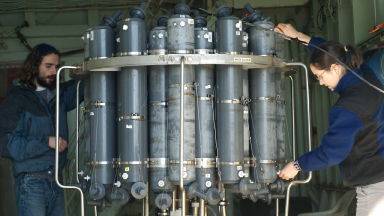|
|||
After spending the early part of her career concentrating on nutrient dynamics, Mary Jane is now focusing on how the availability of light affects phytoplankton growth. Her research, which uses both optics and remote sensing techniques, has been instrumental in determining the factors contributing to the initiation of phytoplankton blooms in the Atlantic and Pacific Oceans.
The Perry Phytoplankton and Optics lab, located at the Darling Marine Center in Walpole, Maine, focuses on the relationships between water's optical properties and phytoplankton growth and abundance. Using a variety of sensors and platforms (such as gliders, floats, and CTDs) it is possible to measure ocean dynamics over different time scales. The data from new autonomous sensors can be combined with satellite ocean color measurements to provide a better understanding of the fate of carbon taken up by phytoplankton.
"It's all coming together in terms of our abilities to observe complete cycles in remote places for extended periods of time."-Mary Jane Perry |


